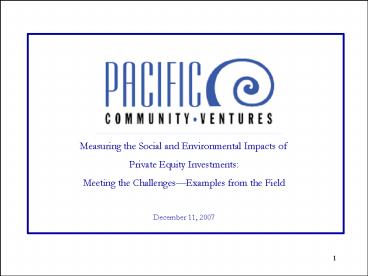Pacific Community Ventures - PowerPoint PPT Presentation
1 / 14
Title:
Pacific Community Ventures
Description:
Are you having a bigger impact in your state than you know? Third party fund managers ... of proof is 'preponderance of the evidence.' Desire for proof 'beyond ... – PowerPoint PPT presentation
Number of Views:33
Avg rating:3.0/5.0
Title: Pacific Community Ventures
1
Measuring the Social and Environmental Impacts of
Private Equity Investments Meeting the
ChallengesExamples from the Field December 11,
2007
2
Agenda
- Why measure social return?
- Brief Introduction to Pacific Community Ventures
- Measuring SROI on Private Equity
- ExampleCalPERS California Initiative
- Process
- Challenges/Solutions
- For more information
3
Financial return is primary.
4
Why measure social return?
- Public pension funds
- Are your ETIs producing benefits in your
geography? If not, why bother? How do you know? - Are you having a bigger impact in your state than
you know? - Third party fund managers
- Demonstrating specific, measurable community
benefits alongside competitive financial returns
is a compelling competitive advantagewill
attract more capital. - All investors who care about social outcomes
- Show that you are producing competitive financial
return AND significant social returnit can be
done! - What you measure, you can increase.
5
60 million under management
Capacity building for small businesses
Asset-building for lower income workers
- PCVs portfolio
- Consulting clients
- Pension Funds
- 3rd-Party Mgrs
- Foundations
6
Example CalPERS California Initiative
- 975 million ETI
- 475 million allocated in 2001, 10 funds, 100
companies - 500 million allocated in 2006, committed to
third-party fund-of-funds manager. - Objectives
- To earn attractive risk-adjusted returns
- As an ancillary benefit, to have a meaningful
impact on the economic infrastructure of
Californias underserved communities. To invest
in companies - Located in areas where access to institutional
capital is limited - That employ workers who reside in economically
disadvantaged areas - With female and/or minority management or
ownership
7
CalPERS California InitiativeNon-Financial
Outcomes
- PCV conducts an annual evaluation of the
non-financial outcomes for the entire 975
million commitment.
8
Results Providing capital to areas that
historically had limited access to institutional
equity capital.
9
Results Employing workers living in
economically disadvantaged areas
10
Results Supporting women and minority
entrepreneurs and managers
11
Data Categories
- Varies with client objectives
- Hourly and salaried wages
- Job quality
- Health insurance
- Asset-building
- Training
- Opportunities for advancement
- Employee tenure
- Patents
- In-state and minority supplier relationships
- Community and environmental initiatives
- Corporate philanthropy
12
Measuring the California Initiatives Community
Outcomes--Process
- Identify key metricsthe yardsticks
- Develop survey instruments
- Work through the funds to collect data from each
portfolio company. Very high participation rates
(90) - Analyze and compile comparative statistics
- Report
- Conduct annually, beginning in 2005
13
Challenges and Solutions
14
For More Information
Beth Sirull Director Pacific Community
Ventures 415-442-4315 BSirull_at_pcvmail.org































